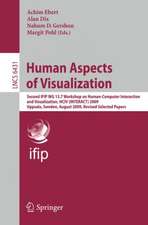Multisensory Softness: Perceived Compliance from Multiple Sources of Information: Springer Series on Touch and Haptic Systems
Editat de Massimiliano Di Lucaen Limba Engleză Paperback – 17 sep 2016
Multisensory Softness focuses on the cognitive mechanisms underlying the use of multiple sources of information in softness perception. Divided into three sections, the first Perceptual Softness deals with the sensory components and computational requirements of softness perception, the second Sensorimotor Softness looks at the motor components of the interaction with soft objects and the final part Artificial Softness focuses on the identification of exploitable guidelines to help replicate softness in artificial environments.
| Toate formatele și edițiile | Preț | Express |
|---|---|---|
| Paperback (1) | 331.25 lei 43-57 zile | |
| SPRINGER LONDON – 17 sep 2016 | 331.25 lei 43-57 zile | |
| Hardback (1) | 337.52 lei 43-57 zile | |
| SPRINGER LONDON – 11 aug 2014 | 337.52 lei 43-57 zile |
Din seria Springer Series on Touch and Haptic Systems
- 20%
 Preț: 642.65 lei
Preț: 642.65 lei - 20%
 Preț: 643.50 lei
Preț: 643.50 lei - 20%
 Preț: 302.30 lei
Preț: 302.30 lei - 20%
 Preț: 919.05 lei
Preț: 919.05 lei - 20%
 Preț: 689.83 lei
Preț: 689.83 lei - 20%
 Preț: 642.52 lei
Preț: 642.52 lei - 20%
 Preț: 584.91 lei
Preț: 584.91 lei - 20%
 Preț: 644.33 lei
Preț: 644.33 lei - 20%
 Preț: 638.37 lei
Preț: 638.37 lei - 20%
 Preț: 644.33 lei
Preț: 644.33 lei - 20%
 Preț: 644.98 lei
Preț: 644.98 lei - 20%
 Preț: 338.16 lei
Preț: 338.16 lei - 20%
 Preț: 337.52 lei
Preț: 337.52 lei - 20%
 Preț: 332.24 lei
Preț: 332.24 lei - 20%
 Preț: 651.75 lei
Preț: 651.75 lei - 20%
 Preț: 603.89 lei
Preț: 603.89 lei - 20%
 Preț: 367.61 lei
Preț: 367.61 lei - 20%
 Preț: 588.39 lei
Preț: 588.39 lei - 20%
 Preț: 763.83 lei
Preț: 763.83 lei - 20%
 Preț: 1035.18 lei
Preț: 1035.18 lei - 20%
 Preț: 923.16 lei
Preț: 923.16 lei
Preț: 331.25 lei
Preț vechi: 414.07 lei
-20% Nou
Puncte Express: 497
Preț estimativ în valută:
63.39€ • 65.78$ • 52.98£
63.39€ • 65.78$ • 52.98£
Carte tipărită la comandă
Livrare economică 17-31 martie
Preluare comenzi: 021 569.72.76
Specificații
ISBN-13: 9781447170617
ISBN-10: 144717061X
Pagini: 257
Ilustrații: XIII, 257 p. 80 illus.
Dimensiuni: 155 x 235 x 14 mm
Greutate: 0.39 kg
Ediția:Softcover reprint of the original 1st ed. 2014
Editura: SPRINGER LONDON
Colecția Springer
Seria Springer Series on Touch and Haptic Systems
Locul publicării:London, United Kingdom
ISBN-10: 144717061X
Pagini: 257
Ilustrații: XIII, 257 p. 80 illus.
Dimensiuni: 155 x 235 x 14 mm
Greutate: 0.39 kg
Ediția:Softcover reprint of the original 1st ed. 2014
Editura: SPRINGER LONDON
Colecția Springer
Seria Springer Series on Touch and Haptic Systems
Locul publicării:London, United Kingdom
Cuprins
Introduction.- Section 1: Perceptual Softness.- Physical Aspects of Softness Perception.- Visual-Haptic Softness.- Vibrotactile Sensation and Softness Perception.- Auditory Perception of Material Properties.- Computational Aspects of Softness Perception.- Section 2: Sensorimotor Softness.- Exploratory Movement Strategies in Softness Perception.- The Perception of the Centre of Elastic Force Fields: A Model of Integration of the Force and Position Signals.- Dynamic Combination of Movement and Force for Softness Perception.- Perception of Stiffness with Delay.- Section 3: Artificial Softness.- Natural and Artificial Motion Feedback in Compliance Perception.- Softness Displays.- Haptic Augmentation in Soft Tissue Interaction.
Textul de pe ultima copertă
Offers a unique multidisciplinary overview of how humans interact with soft objects and how multiple sensory signals are used to perceive material properties, with an emphasis on object deformability. The authors describe a range of setups that have been employed to study and exploit sensory signals involved in interactions with compliant objects as well as techniques to simulate and modulate softness – including a psychophysical perspective of the field.
Multisensory Softness focuses on the cognitive mechanisms underlying the use of multiple sources of information in softness perception. Divided into three sections, the first Perceptual Softness deals with the sensory components and computational requirements of softness perception, the second Sensorimotor Softness looks at the motor components of the interaction with soft objects and the final part Artificial Softness focuses on the identification of exploitable guidelines to help replicate softness in artificial environments.
Multisensory Softness focuses on the cognitive mechanisms underlying the use of multiple sources of information in softness perception. Divided into three sections, the first Perceptual Softness deals with the sensory components and computational requirements of softness perception, the second Sensorimotor Softness looks at the motor components of the interaction with soft objects and the final part Artificial Softness focuses on the identification of exploitable guidelines to help replicate softness in artificial environments.
Caracteristici
Multidisciplinary analysis of how skin pressure, proprioception, tactile vibration, vision and audition lead to the impression of material compliance Provides an overview of experiments, techniques and setups in the perception of softness Explains how sensory signals are used to perceive softness and how to reproduce interaction with soft materials Includes supplementary material: sn.pub/extras











